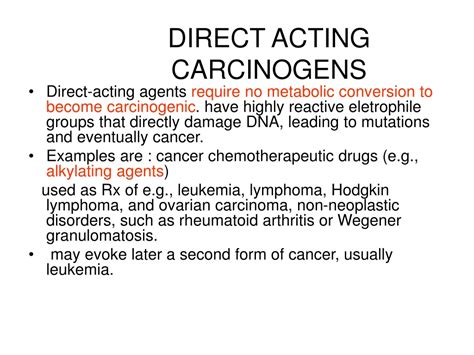direct acting carcinogens|Key Characteristics of Carcinogens as a Basis for : Pilipinas Direct-acting carcinogens (e.g., nitrogen mustard and some metals such as nickel): capable of binding to the DNA and directly causing genetic damage. Indirect carcinogens : must . Learn more about Karlee Grey, the stunning adult film star and model. Discover her hobbies, interests, and passions in her own words.

direct acting carcinogens,Direct- and indirect-acting genotoxic cancer-causing agent, primarily absorbed by epidermal components, such as DNA bases (thymine and cytosine) and proteins. This agent is implicated in the causation of skin tumours by targeting .

Direct- and indirect-acting genotoxic cancer-causing agent, primarily absorbed by .PAH-DNA immunostaining of human prostate. (A) Representative example of .
Key Characteristics of Carcinogens as a Basis for Alkylating chemical carcinogens either directly interact with cellular genomic material (direct-acting carcinogens), or must first be metabolized by the host to a reactive species .Direct-acting carcinogens (e.g., nitrogen mustard and some metals such as nickel): capable of binding to the DNA and directly causing genetic damage. Indirect carcinogens : must .chemical carcinogens are direct-act-ing electrophiles, whereas others re-quire biotransformation by enzymes in a process termed metabolic acti-vation (Miller, 1970). .Some chemical carcinogens are direct-acting electrophiles (e.g. formaldehyde; sulfur mustard, and ethylene oxide), whereas others require biotransformation by enzymes in a .Some chemical carcinogens are direct-acting electrophiles, whereas others require biotransformation by enzymes in a process termed metabolic activation (Miller, 1970). .direct acting carcinogensUnderstanding how chemical carcinogens exert their biological effects furthers understanding of mechanisms of carcinogenesis and offers opportunities for monitoring .
Melphalan (4-[bis(chloroethyl)amino]phenylalanine) is a direct-acting, bifunctional, alkylating agent that binds to cellular macromolecules including DNA, RNA .
The 10 characteristics are the abilities of an agent to 1) act as an electrophile either directly or after metabolic activation; 2) be genotoxic; 3) alter DNA repair or cause .Direct-acting carcinogens include β-propriolactone, epoxides, imines, alkyl and sulfate esters, halogen derivatives such as mustard gasses, halo ethers (bis(chloromethyl)ether), nitrosamides, and nitrosoureas (N-methylnitrosourea and N-methyl-N′-nitro-N-nitrosoguanidine). Direct-acting electrophilic chemicals typically test positive in the .Some chemical carcinogens are direct-acting electrophiles, whereas others require biotransformation by enzymes in a process termed metabolic activation (Miller, 1970). Examples of direct-acting electrophilic carcinogens are formaldehyde, sulfur mustard, and ethylene oxide (see Chapter 1, by Bond and Melnick). The classic examples of chemical .
Two categories have been identified, those capable of causing DNA damage and mutations directly (genotoxic, or direct-acting, carcinogens) and those that require prior metabolic activation by cells of the host to be converted to mutagens (epigenic, or indirect-acting, carcinogens). In the industrial countries much progress has been made in .
The direct-acting carcinogens interact with macromolecules through the covalent bond formation between an electrophilic form of the carcinogen and the nucleophilic sites in proteins (e.g., S, O, and N atoms in cysteine, tyrosine, and histidine, respectively) and nucleic acids (e.g., N and O atoms in purine or pyrimidine), such as Busulfan (1,4-butanediol dimethane sulfonate) is a direct-acting bifunctional alkylating agent which has been widely used for the treatment of chronic myeloid leukemia prior to the introduction of Imatinib. Busulfan produces acute myeloid leukemia. The primary mechanism of carcinogenesis is through genotoxicity. A direct-acting carcinogen does not require metabolic activation. Historically, the terms procarcinogen, proximate carcinogen, and ultimate carcinogen refer to the parent compound (procarcinogen) and its metabolite forms, either intermediate (proximate carcinogen) or final (ultimate carcinogen) that reacts with DNA ( Figure 15.1 ).

Carcinogenic chemicals are extremely diverse in structure and function and can be divided into the following two categories: direct-acting and indirect-acting carcinogens, according to the difference in inducing DNA damage directly or indirectly, respectively (Lutz, 1986).Direct-acting carcinogens, due to their electrophilic groups, can directly induce . This document discusses carcinogens and carcinogenesis. It defines carcinogenesis as the mechanism of inducing tumors, and carcinogens as agents that can induce tumors. Carcinogenesis is discussed under chemical, physical, and biological carcinogens. Chemical carcinogens are divided into direct-acting and indirect-acting .
direct acting carcinogens|Key Characteristics of Carcinogens as a Basis for
PH0 · Tumour Site Concordance and Mechanisms of Carcinogenesis.
PH1 · Tumour Site Concordance and Mechanisms of Carcinogenesis
PH2 · Tumour Site Concordance and Mechanisms of
PH3 · Overview of biological mechanisms of human carcinogens
PH4 · Key characteristics of carcinogens
PH5 · Key Characteristics of Carcinogens as a Basis for
PH6 · Chemical carcinogens
PH7 · Chemical Carcinogens
PH8 · Carcinogens and DNA damage
PH9 · Carcinogen
PH10 · 10. Key characteristics of carcinogens